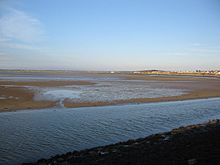Beddmanarch–Cymyran facts for kids
| Site of Special Scientific Interest | |

Low tide at Traeth y Gribin
|
|
| Area of Search | West Gwynedd |
|---|---|
| Coordinates | 53°17′00″N 4°35′16″W / 53.28345°N 4.5879°W |
| Interest | Biological |
| Area | 911 hectares (2,250 acres) |
| Notification | 1961 |
Beddmanarch–Cymyran is a special natural area on the Welsh island of Anglesey. It's called a Site of Special Scientific Interest (SSSI). This means it's a place with important plants, animals, or geology that needs to be protected.
The site covers over 900 hectares (about 2,200 acres). It's mainly focused around the Cymyran Strait. This area was first recognized as special in 1961. It's important for its coastal plants and many different birds. Because it includes areas where the land meets the sea, it's also a marine protected area.
Contents
What is Beddmanarch–Cymyran?
Beddmanarch–Cymyran is a large natural area. It includes salt-marshes, mud-flats, and shallow coastal water. These are all important habitats for wildlife. The site stretches between Holy Island and the main part of Anglesey.
It covers the Cymyran Strait, which is sometimes called the Holy Island Strait. It also includes parts of the Afon Alaw river to the east. The area goes north up to Porth Penrhyn-Mawr.
There are two ways to cross the water in this area. One is Four Mile Bridge, which is for cars and people. The other is the Stanley Embankment, used by cars, trains, and people. The part of the water between these two crossings is known as the Inland Sea.
Why is This Place Special?
Beddmanarch–Cymyran is very important for several reasons. It has four main areas of special interest:
Marine Life
The site is home to important marine life. This includes all three types of eelgrass found in Britain. Eelgrass (Zostera) is a special underwater plant. It provides food and shelter for many sea creatures.
Salt Marsh Plants
The salt marshes here have unique plants. These plants can grow in salty soil. Examples include glasswort, common saltmarsh-grass, and thrift. You can also find lax-flowered sea-lavender and sea rush. An uncommon plant called golden samphire (Inula crithmoides) also grows here.
Coastal Dune Heath
This area has coastal dune heath. This means it has sandy hills with special plants. You'll find heather growing here. There are sand wedges at Traeth y Gribin and Cymyran.
Wintering Water Birds
Many water birds come here in winter. They use the area to feed and rest. Some of these birds include ringed plovers, curlews, and greenshanks. You might also see red-breasted mergansers, goldeneye ducks, and brent geese.
The area also has a mix of other environments. These include mudflats, sandbanks, and rocky areas. There are also shingle bars, muddy gravels, and coastal grasslands. All these different places support a wide variety of wildlife. This includes birds that breed here, like arctic and common terns. Special plants like dwarf rush (Juncus capitatus) and spiral tasselweed (Ruppia cirrhosa) also grow in this area.
As a marine protected area, it's especially important for certain species. These include the common ringed plover and common greenshank. It's also vital for eelgrass and algae that grow in the tides. The different habitats like salt marsh and muddy gravel are also protected. The RSPB helps to keep an eye on the wintering populations of ringed plovers and greenshanks.
What Dangers Does It Face?
Even though Beddmanarch–Cymyran is protected, some things can harm it. Here are some of the risks:
- Changes to Tides: If the way the tides flow changes, it can affect the "Inland Sea." This area provides important mudflats for birds when other places are covered by high tide.
- Sediment Levels: Low levels of mud and sand in the water help eelgrass grow. If these levels change, it could harm the eelgrass beds.
- Grazing: Light grazing by animals helps the heather grow well on the coastal heath. Paths and tracks also create bare ground where dwarf rush can start to grow.
- Pollution: Fertilizers and extra food can increase nutrient levels in the soil. This can cause common grasses and seaweed to grow too much. This then harms other special plants.
- Beach Activities: People enjoying the beach can sometimes disturb nesting ringed plovers. They can also bother wintering water-birds and nesting terns.
- Shooting: Hunting can scare away birds from their feeding areas. However, shooting is controlled here, and there are special "sanctuary zones" where no shooting is allowed.
- New Species: Sometimes, new plants or animals that are not native to the area appear. For example, wireweed (Sargassum muticum), an alien seaweed, can show up. Their presence is watched closely.
- Bait Digging: Digging for bait can affect the muddy gravel areas. But if people fill in their pits and put back any moved rocks, it helps reduce the problem.
How is it Managed?
Many activities in the area need to be checked with Natural Resources Wales. They might also need special permission. There are 28 types of activities listed that could affect the site. These include farming, fishing, using water, and bringing in or taking out plants and animals. These rules don't stop all activities. But some might be limited to certain areas or times of the year to protect the site.

